Introduction
Sexting is a term that originated in the media by collapsing the terms sex and texting. It is generally defined as the digital recording of nude or sexually suggestive or explicit images and their distribution by mobile phone messaging or through social networking platforms such as Facebook, Instagram and Snapchat (Lee et al. 2015). In this study, the term sexting also extends to the sending and receiving of sexually suggestive texts.
Legislators, policymakers and the media have noted and responded to the risks associated with sexting including child pornography, non-consensual use of images and coercion. However, despite this, in a recent Australian study of young people the majority of sexting was found to occur without negative consequences and within existing relationships. It also suggests that while a significant number of young people engage in consensual sexting, only a small number do so frequently.
In March 2017, Relationships Australia’s monthly online survey asked visitors to our website to report on their experiences of sexting. The study sought to determine whether the trends and potential risks of sexting identified in previous research were confirmed for an older cohort of men and women accessing the Relationships Australia website.
Previous research finds that…
- In a survey of over 2,000 young people aged 13 to 18 years:
- Almost half reported having sent a sexual picture or video of themselves to another party, while two-thirds had received a sexual image.
- Sexting was prevalent among all age groups, with 13 to 15 year olds particularly likely to receive sexual images.
- Sexting was prominent among homosexual and bisexual respondents.
- Most sexting occurred between partners in committed relationships (Lee et al. 2015)
- In overseas research the gendered dynamics of sexting was found to occur in the context of a ‘gendered double standard’ (Dobson & Ringrose, 2013; Albury et al. 2015). Young women and girls generally have more to lose when ‘consensual’ sexting goes wrong, and are more likely to feel pressured or coerced into sending an image.
Results
More than 1750 people responded to Relationships Australia’s online survey in March 2017. Three-quarters (75%) of survey respondents identified as female, with more females than males responding in every age group (figure 1). Eighty-five per cent of survey respondents were aged between 20 to 59 years, while more than one-third (37%) of respondents comprised women aged between 30 to 49 years (inclusive).
As for previous surveys, the demographic profile of survey respondents remains consistent with our experience of the groups of people that are accessing the Relationships Australia website.
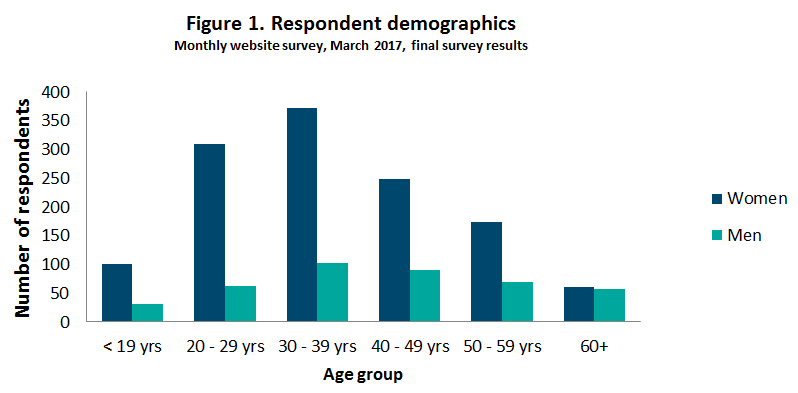
A substantial majority of survey respondents reported that they were married (35%) or in a long-term relationship (28%). Fewer than one-quarter of respondents reported that they were not in a relationship (23%) and a small number of people reported that they were in a casual relationship (4%) or had just started seeing someone (4%).
More than half of women (54%) and fewer than half of men (45%) reported that they had sent a sexually suggestive message, picture or video of themselves (figure 2).
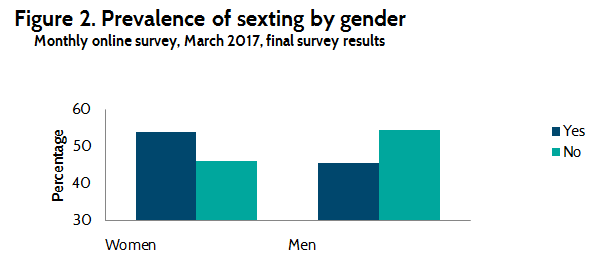
The main reason cited by both men and women for sending a sexually suggestive message, picture or video of themselves was to be fun or flirty (men 65%, women 58%), consistent with previous studies examining sexting behaviour. The second most common reason reported by men for sexting was because they had received one, while women were more likely to report that they had sexted as a ‘sexy present’. Women were more likely than men to report that they had sexted in the past to get or keep a person’s attention (men 6%, women 7%) or because they were pressured to send it (men 1%, women 6%).
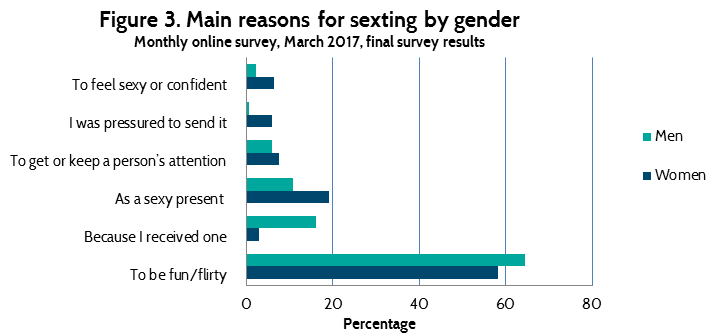
Thirty per cent of women and twenty-six per cent of men reported having received a sexually suggestive message, picture or video from one person in the last three years (Figure 4). Fewer than one-fifth of survey respondents reported receiving a ‘sext’ from two to five people while just under half of survey respondents reported they had not received a sexually suggestive message, picture or video in the past three years.
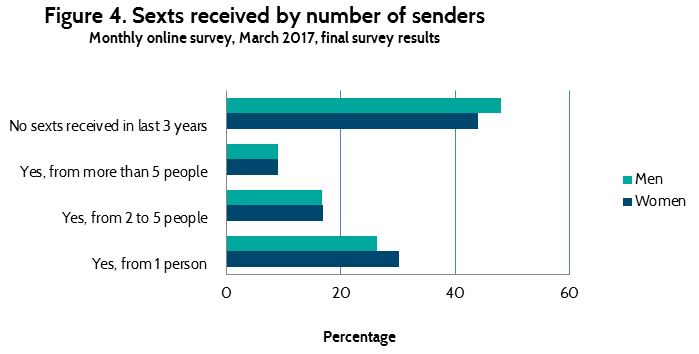
Men and women who were in a long term relationship were more likely to report (39%) that they had sent a sexually suggestive message, picture or video than married people (27%). Men and women in a casual relationship or who had just started seeing someone were more likely report they had sent a sexually suggestive message, picture or video than they had not sent a sexually suggestive message, picture or video (Figure 5)
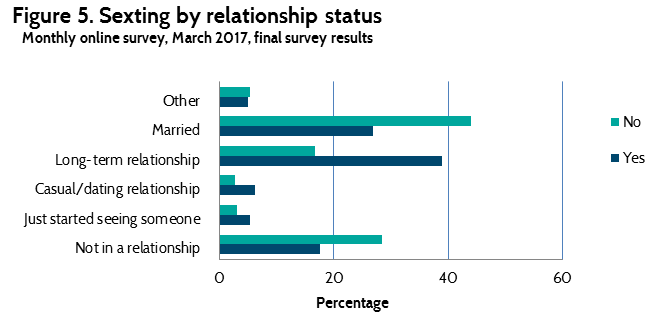
References
Albury K, Crawford K, Byron P and Mathews B (2013). Young people and sexting in australia: Ethics, representation and the law. Sydney: ARC
Centre for Creative Industries and Innovation. http://www.cci.edu.au/sites/default/files/Young_People_And_Sexting_Final.pdf
Dobson AS and Ringrose J (2015). Sext education: pedagogies of sex, gender and shame in the schoolyards of Tagged and Exposed. Sexuality, Society and Learning, Volume 16(1)
Lee, M, Crofts, T, McGovern, A. & Milivojevic, S. (2015). Sexting among young people: Perceptions and practices, Trends & issues in crime and criminal justice no. 508. Canberra: Australian Institute of Criminology, December
